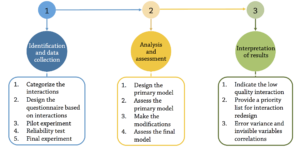The User-Product Interaction Evaluation (UPIE) Model
(Ph.D. Thesis)
A Structured Method for Testing and Improving the Product Design
Interaction design is based on a dialogue between a user and a product, service, or system. This dialogue can be both physical and emotional. Interactions result from the process of action and reaction between user and form, function, and technology. User-product interaction design also includes preparing the user for certain conventions, symbols, and functionality in the application of a product.
Design evaluation plays a significant role in the design process and as  a heart of the design lifecycle it became a proficiency in design. Affordance (the characteristics of a product or system and the design features that help users to perform tasks) also plays an important role in user-product interaction design. Studying and evaluating the interactions in a designed object can help reveal a better perception of usability for the designer, and consequently, better interaction.
a heart of the design lifecycle it became a proficiency in design. Affordance (the characteristics of a product or system and the design features that help users to perform tasks) also plays an important role in user-product interaction design. Studying and evaluating the interactions in a designed object can help reveal a better perception of usability for the designer, and consequently, better interaction.
In this research, we focused on the contribution model of a behavioral relationship between user and product through the multi-disciplinary aspect of design, with respect to affordance, usability and related fields and in combination with Confirmatory Factor Analysis (a statistic method in behavioral sciences). We then summarized and systematically explained how affordance analysis and evaluation can contribute to User-Product Interaction and how usability is generally focused on cognitive and functional information. As a result, the User-Product Evaluation (UPIE) Model was developed as a structured evaluation method for testing, designing, and improving user-product interaction.
The proposed UPIE model is a new approach in user-product interaction that is focused on product design from the interaction perspective. This model is a combination of design science and statistics, which provides a new perspective for designers when interpreting evaluation results. This research describes the evaluation method within an experiment that studied users’ interactions with a high-end coffee machine, through the lenses of human science and usability evaluation. In our UPIE model, the final concept is derived from identification of relationships between human experience, affordance knowledge, and context-of-use. The final results of the evaluation model consequently reveal the interactions’ correlations that influence designers’ and users’ concepts of evaluation in product interactions. These relationships were used to form a hypothesis that certain evaluation principles in statistics science can inform the evaluation model with respect to aspects of affordance that trigger people’s understanding of a product’s use. Ultimately, the User-Product Interaction Evaluation was devised to help designers design products that are more user-friendly and therefore more desirable to consumers.
